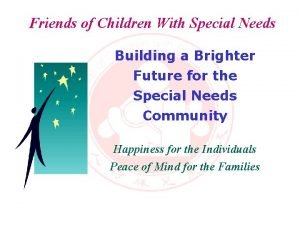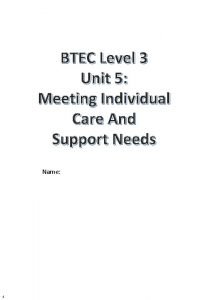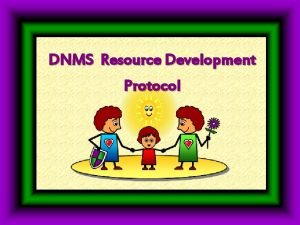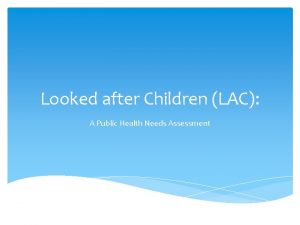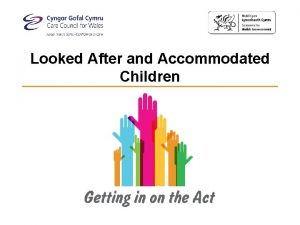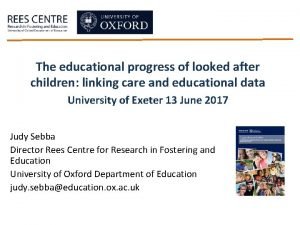Meeting The Needs of Previously Looked After Children



















- Slides: 19

Meeting The Needs of Previously Looked After Children (PLAC) Carol Booth & Louise Brennand Educational Psychologists

Objectives ● To provide a context to the Previously LAC school population ● To introduce developmental trauma and its impact on the child ● To use Schofield and Beek’s Secure Base Model to support classroom practice ● To introduce the Resources Directory

Previously Looked After Children Wide group which collectively refers to children who have: ● Been adopted from care ● Left local authority care on a Special Guardianship Order (SGO) ● Become the subject of a Child Arrangement Order

Key Documentation ● NICE guidelines 2015: Children’s Attachment: Attachment in children and young people who are adopted from care, in care or who are at high risk of going into care Statutory guidance for local authorities: ● February 2018: Promoting the education of looked after children and previously looked after children ● November 2018 : Mental health and behaviour in schools ● Resources Directory

Statistics ● 370 previously looked after children in Northumberland ● 75% of adopted children are exposed to alcohol in the womb (Gregory et al. 2015) ● 74% experience abuse and neglect at the hands of their birth families (NICE 2013) ● 56% of children under SGO have experienced neglect ● On average children live with foster carers for two and a half years before adoption ● 69% of adoptive parents do not have children prior to adopting (Dance 2015) ● A fifth of adopted children are at school age when they are placed (Df. E 2015) ● Adoptive families often experience some level of challenge or difficulty

Developmental Trauma Developmental trauma can come about as a result of having experienced or witnessed amongst other things: • Physical abuse • Severe neglect • Domestic violence • Multiple placement moves • Emotional abuse • Deprivation All within the child's close, early relationship with parents and carers in their homes. . (Bomber, 2011)

Neurological development • • Brain cells react to experiences in the environment, which shape the structure of the brain Relationships change brain structures not just thinking

Brain Basics • • • The brain is organised in a hierarchical manner from the bottom up: from the simplest to the most complex processes These parts develop at different times of childhood The principle lends itself to the metaphor of building a house Cortical Limbic Midbrain Brainstem Learning Emotional engagement Movement Safety Mc. Caleb & Mikaere-Wallis, 2005

Developmental Trauma Understanding developmental trauma can help us to understand why a child or young person might. . • Run away or hide from a situation • Act fearfully or aggressively to seemingly minor threats • Be unable to approach adults for help • Have a chronic need for adult attention • Experience distress when away from key adults • Find it hard to trust adults • Find it hard to relinquish control • Find it difficult to make eye contact or engage in dialogue • Be hyper vigilant and easily distracted

Challenges for PLAC ● ● ● ● Building trusting relationships with adults Social skills and interaction with peers Managing emotions and behaviour Coping with transitions and change Using executive functioning skills Self worth and esteem Engaging with learning

Key Features in Becoming a Post LAC Friendly School ● ● ● ● Strategic overview and policy development Knowing your unique population and individual needs Having POST LAC knowledge across whole school Understanding behaviour as a communication Empathic and understanding staff Creative and flexible use of Pupil Premium Plus Checklist for conversation with parents/family members Close home/school links with family

Secure Base Model, Schofield and Beek (2005)

Activity

The key adult provides…. Availability - regular predictable attachment slot build into the school day. -being reliable by explaining unexpected change. Sensitivity - using validation and empathy to support changing emotions - - being aware of background, key triggers and areas of difficulty Acceptance - acknowledging and labelling ‘jigsaw parts’ Bomber - encouraging children to learn and play outside their comfort zone

The key adult provides…. Cooperation - Helping you with jobs/tasks - - Offering choices and negotiation within clear boundaries Membership - Encouraging participation in non classroom based activities - - Document evidence of belonging in school eg year book

Teaching approaches DO make a difference: • • • Be tuned-in to the child’s emotional and mental state (empathise) and reflect this understanding to the child Work with emotional age of child/young person Be aware of a child’s behaviour/projections to re-enact insecure attachment patterns Be sensitive to their need for reassurance, comfort and help in times of genuine stress, confusion, uncertainty Be reliable in responding to these needs

Teaching approaches DO make a difference: • • • Minimise change, especially of adult carers (including school staff) and prepare if change needs to occur Model and encourage self-reflection Provide experiences of success in problem situations Question faulty attributions, provide alternative explanations…learned optimism Treat their personality as a plant not a machine – something that can grow and change through experience.


 After me after me after me
After me after me after me If anyone desires to come after me
If anyone desires to come after me Uncle gregorio of rizal
Uncle gregorio of rizal Pam ayre
Pam ayre Unit 18 assessing children's development support needs p1
Unit 18 assessing children's development support needs p1 Friends of children with special needs
Friends of children with special needs Alpha press murray
Alpha press murray Strategic gender needs and practical gender needs
Strategic gender needs and practical gender needs Primary needs and secondary needs
Primary needs and secondary needs Learning needs definition
Learning needs definition Primary needs and secondary needs
Primary needs and secondary needs Archaebacteria facts
Archaebacteria facts What thailand was previously known as
What thailand was previously known as Ncaa rsro
Ncaa rsro Csun mse 227
Csun mse 227 Meeting the needs of guests with kindness and goodwill.
Meeting the needs of guests with kindness and goodwill. Individual needs examples
Individual needs examples Btec health and social care unit 5 coursework
Btec health and social care unit 5 coursework Methods of meeting customer needs
Methods of meeting customer needs Developmental needs meeting strategy
Developmental needs meeting strategy





